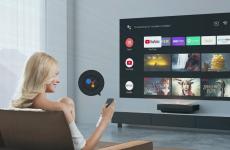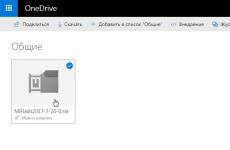What to do if the Start menu does not open. What to do if the Start menu does not open What is the Start screen in Windows 10
In the operating room Windows system 10, the Start menu, so beloved by many users, reappeared. But, at the same time, the initial screen with tiles disappeared. This solution will probably be more convenient for most users.
But, if you actively used Windows 8 and managed to get used to the Start screen and tiles, then you can enable it in Windows 10. In this material We'll talk about how to enable the Start screen in Windows 10.
In order to enable the start screen, you need to right-click on the taskbar and select the “Properties” menu item.
After this, the “Taskbar and Start Menu Properties” window will open in front of you. Here you need to go to the “Start Menu” tab.


After this, a warning window will appear. Here you need to click on the “Log out and change settings” button.


It should be noted that turning on the Start screen completely disables the Start menu. Therefore, you cannot use both the Start menu and the Start screen at the same time.
Many users were unhappy with the appearance of the radically new Start menu in Windows 8 and new version operating system, Microsoft decided to listen to the demands of millions of users from all over the world and gave them a choice: use the full-screen Start menu or install the classic version familiar to users of Windows 7 and older versions of the operating system. Are you new to Windows 10? Here are the instructions for changing appearance Start menu in Windows 10.

The traditional Start menu, installed by default in Windows 10.
By default, Windows 10 comes with the classic design, which looks like a combination of the Start menu from Windows 7 and Windows 8. On the left side you will find a list of frequently used applications and recently added ones, as well as a button that will open you a list of all installed applications. The right side of the menu displays all of your apps' pinned tiles, just like Windows 8.

The Start menu personalization window in Computer Settings.
If you prefer full screen mode display or just want to try an alternative interface, you can change it as follows:

Full screen Start mode in Windows 10.
This will switch the Start menu to full screen mode. similar to Windows 8. Please note that in this case, the computer's power key will appear at the bottom left, along with the all applications button. The list of installed applications will open in the sidebar, and the button will appear on the left top corner will open a panel with frequently used apps and four links to File Explorer, PC Settings, All Apps, and Power Management.
How do I turn off frequently used and recently added apps from showing in the Start menu?

Alternative Start Menu from Stardock.
Bonus.
Of course, no one has canceled third-party applications with which you can change the appearance of the Start menu. If you're still unhappy with the way Microsoft has changed the menu, you can install the classic option, which will look exactly the same as what is used in Windows 7. Please note that to do this you need to use third party applications. Stardock provide a great app called Start10 for just such purposes.
Classic Shell - free program to return the previous appearance of the classic Start menu in the operating systems Windows 10, Windows 8.1, Windows 8, Windows 7, Windows Vista. The program changes the visual display of elements of the Windows operating system for more convenient use.
Many users experience inconvenience when using the Start menu due to the fact that the Windows developer, Microsoft company Constantly changes the settings, options, and appearance of the Start menu.
Therefore, many users want to return the classic Start menu for the operating systems Windows 10, Windows 8.1, Windows 8. In the Windows 7 operating system, users change the appearance of the Start menu in the style of the Windows XP operating system.
Free Classic program Shell returns the classic look of the Start menu, allows you to make extensive settings for display styles, options and design of the start menu.
The Classic Shell program consists of three components:
- Classic Start Menu - return of the classic Start menu
- Classic Explorer - Adding a Toolbar to Windows Explorer
- Classic IE - customizing panels in the browser Internet Explorer
In this article we will look at the operation of the Classic Start Menu component, which allows you to create the old Start menu in the Windows operating system. Not all users need other program components.
The Classic Shell program works in Russian. You can download the Classic Shell program from the official website of the developer. On the downloads page, select the “Classic Shell x.x.x (Russian)” file to download to your computer.
Installing Classic Shell
Installation of the Classic Shell program occurs in Russian and does not cause any difficulties. Go through the Classic Shell installation wizard one by one.
In the Custom Installation window, you must select application components to install on your computer. By default, all components are selected for installation.
We want to bring back the classic Start menu, so we only need to keep the “Classic Start Menu” and “Classic Shell Update” components (for automatic updates).
The “Classic Explorer” and “Classic IE” components change the appearance of Explorer and Internet browser Explorer, and not all users need such changes. Therefore, disable the installation of these components.

Classic Shell for Windows 10
After left-clicking on the Start menu, you will see the classic Windows 7-style Start menu installed in the Windows 10 operating system. This is what the Start menu looks like with default settings.

The classic Start menu for Windows 8.1 or Windows 8 will look similar.
Setting up Classic Shell
After installing the application, the “Classic Start Menu Options” window will open. In this window, all program parameters are configured.
You can change Classic Shell settings at any time. To do this, right-click on the “Start” menu and select “Settings” in the context menu.

In the “Start Menu Style” tab, you can select a classic style for the Start menu in the style of the Windows XP or Windows 7 operating systems.
With default settings, the standard Start button is displayed on the Desktop. Instead of the button image from the operating system, you can set the image from Classic Shell (two options) or add your own image if you have a similar image.
By default, the main settings in the program are made in the tabs: “Start Menu Style”, “Basic Settings”, Cover”, “Start Menu Customization”.

Check the box next to “Show all parameters” to configure other parameters in the Classic Shell program.
After this, they will become available additional settings in the tabs: “Menu View”, “Start Button”, “Taskbar”, “ Windows Settings 10", " Context menu", "Sounds", "Language", "Controls", "Main Menu", "General Behavior", "Search Field".

Although the program is configured optimally by default, the user can independently change the application settings to suit his needs by experimenting with the settings. To do this, select the settings, see what happened after changing them. If it turns out that you went a little overboard with the settings changes, you can return the program settings to their defaults.
In the application settings, you can hide unnecessary functions, change the display of elements and icons, change the order of elements, and remove elements from the Start menu.
To do this, select the element, select a command and display. After right-clicking on the desired element, select additional functions.
In the “Cover” tab you can select a cover for standard menu"Start". By default, Windows 10 uses the Metro skin. You can choose from other skins: Windows Aero, Metallic, Midnight or Windows 8, a minimalist Classic Skin or No Skin.

Classic Shell parameter settings can be saved to an XML file in order to load settings from this file when new installation Classic Shell programs. To do this, use the “Archive parameters” button, select the desired option: “Save to XML file” or “Load from XML file" To reset the program's settings to default, select "Reset all settings."
Removing Classic Shell
Classic Shell program is uninstalled in a standard way. If the program was not uninstalled correctly, or some problems arose during the uninstallation process, use special utility which can be downloaded from here.
Conclusion
The free Classic Shell program installs an alternative (formerly classic) Start menu in the Windows operating system. After installing the program on the computer, the user can return the classic appearance of the Start menu in Windows 10, Windows 8.1, Windows 8, Windows 7, and make other changes to the appearance and settings of the start menu.
The ability to customize your desktop in Windows 10 allows you to make the operating system more personal, and it may even help you be more productive. So today we'll look at some settings that everyone should know to improve their OS experience.
Perhaps one of the most strengths Windows is able to customize almost everything; Users can customize their desktop with available options in the operating system and even through settings in the registry and policies. You can Carry out more fine tuning after installation.
Customize the Start menu just the way you like it
The Start menu in Windows 10 is very similar to what you used to experience in Windows 7. However, it also combines parts of the Start screen from Windows 8.1, and it's one of the first features you'll want to customize.
Just like Windows 8.1, Windows 10 offers the ability to drag and group Live Tiles any way you want. If you want to name the group, just right-click on the top edge of the group and name it whatever you want.

In Live Tiles mode you can view latest information without having to open the app. But sometimes you may not like or need to see certain information. While you can't turn off this feature globally, you can right-click on each tile and select "Turn off Live Tiles."
Is a touchscreen required for Windows 10?
No, the operating system works just fine with a mouse and keyboard. Owners of ordinary liquid crystal and cathode ray monitors will not feel any inconvenience.
Will the Start screen remain in Windows 10?
In 2012, with the advent of Windows 8 and the home screen, the user experience with the system has changed radically. This was a new approach to organizing the interface with Windows. Since then, Microsoft has tried in every possible way to improve the work with operating system. Although the changes seem too profound to many, the new interface has gained loyal supporters. The developers of Windows 10 have returned the familiar Start menu. It embodies the desire to combine the advantages of both methods, to find a compromise for Windows users 8 and Windows 7. This article will show you how Windows 8 and Windows 8.1 users who still prefer to use the Start screen can quickly turn it on on the go and experience some of the improvements.

Enabling tablet mode
If you're upgrading from earlier releases such as Windows 8.0, be prepared to experience some new features. Features such as Semantic Zoom, Start Tip are no longer available or have been moved and renamed. To turn off the Start screen (now called Tablet Mode), simply open the Notification Center in the Notification Area on the taskbar and click Tablet mode (see screenshot above).

Home screen
You'll find yourself on a Start screen similar to Windows 8. Instead of scrolling horizontally, you'll scroll the screen vertically and can click on the menu in the top left corner (three horizontal bars) to access the App Library (see screenshot above). One obvious difference is that the taskbar is always on the screen.

Selecting an application using the task view icon
In tablet mode, applications will not be placed on the taskbar. Instead, you find running programs by clicking the Taskview task view icon next to the "magnifying glass" search icon (see screenshot above). You will be able to switch between applications using the Alt + Tab key combination if you are using a keyboard.
How are applications and programs launched?

Launch apps from your frequently used list
To launch the application, click the Start button to display the start screen. Launch the app you want if it's already pinned to your Start screen. If it's not there, click the Hamburger menu in the top left corner of the screen and launch from the list of frequently used apps or from the All Apps list (see screenshot above). Please note that features such as Jump List are now available, which were not available in the past. Access to the entire application library is shown in the screenshot below.

Access to the entire application library
To exit tablet mode, click the Notification icon and Tablet mode.
How do I enable the full Home screen without tablet features?

Enable the full Home screen without tablet features
If you want to opt out of tablet features, you can still enable Full Screen from the Settings section. Click Start, Settings, or press a combination Windows keys+ i. Click Personalization and then Start. Under Start behaviors, turn on Use full-screen Start when in the desktop. , as shown in the screenshot above.
Now you can combine best qualities both approaches.
Has touch functionality been removed from Windows 10?
No, they are available for touch devices.






